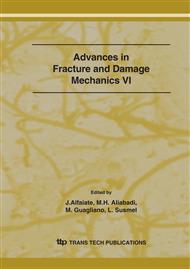p.237
p.241
p.245
p.249
p.253
p.257
p.261
p.265
p.269
The Use of the Singular Elastic Peak Stress Evaluated by FE Analyses for Fatigue Strength Assessment of Welded Joints
Abstract:
The paper presents a simplified version of the Notch Stress Intensity Factor (NSIF) approach useful for fatigue strength assessments of welded joints. The evaluation of the NSIF from a numerical analysis of the local stress field usually needs very refined meshes and then large computational effort. A relationship is proposed here to estimate the Notch Stress Intensity Factor from finite element analyses carried out by using a mesh pattern with a constant element size. The main advantage of the presented relationship is that only the elastic peak stress numerically evaluated at the V-notch tip is necessary to estimate the NSIF instead of the whole stress-distance set of data (that is why the method has been called Peak Stress Method, i.e. PSM). An application of the PSM to fatigue strength assessment of fillet welded joints made of structural steels and aluminium alloys under tensile or bending loads is presented. In those joints, only mode I stress distribution is singular at the weld toe due to the presence of a V-notch angle equal to 135 degrees.
Info:
Periodical:
Pages:
253-256
Citation:
Online since:
September 2007
Authors:
Price:
Сopyright:
© 2007 Trans Tech Publications Ltd. All Rights Reserved
Share:
Citation:


